by John Semlak | Jul 6, 2016 | #AmericanRevolution
New York’s Revolutionary War past is in some ways very low key and unappreciated. For most of the war the city was occupied by the British and liberated by George Washington at the very end of the war. In later years New York gained a deserved reputation as a center of American finance, immigration, media, and entertainment; and many of popular tourist sites rightly commemorate this history. Today’s New York City has little resemblance to the colonial-era town that stood here in the late 1700s. Only a handful of landmarks remain.
Nevertheless if you look around you while exploring New York City, you’ll find the city is full of history of the Revolutionary War. Some of it is commemorated by monuments and plaques. Some exists within buildings that survive from the period. Here is my list of 8 essential sites in New York City for experiencing the Revolutionary War:
1. Bowling Green
New York City’s oldest public park, it was the site of the most profound act against the British by local patriots in the early stages of the Revolution. A statue to King George III stood on the park, which was already a target of protests. On July 9th, when the Declaration of Independence was read in New York City near today’s City Hall, local Sons of Liberty rushed to tear down the statue, which of course no longer stands at the sites. Bits of the statue are preserved at the New-York Historical Society. The statue was protected by an iron fence which still stands today. The posts were topped with metal royal crowns, which where sawed off by the patriots.

Bowling Green Park. The cast-iron fence around it was erected to protect a statue of King George II, a frequent target of vandels.
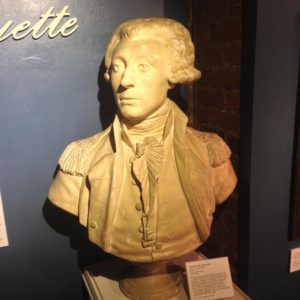
Bust of Lafayette in Frances Tavern
2. Fraunces Tavern
The tavern opened in 1762 and was a frequent meeting place of patriots in the years leading up to the Revolution, and visited several times by George Washington. Today’s building is a 1903 reconstruction that attempted model the colonial-era design, though some of the original bricks remain. In addition to the tavern on the ground floor, the upper two floors are a museum dedicated to New York during the American Revolution. George Washington and the Marquis de Lafayette are heavily featured. The highlight is the Long Room, a banquet room where Washington retired from the Continental Army on December 4th 1783.
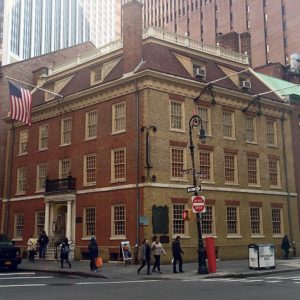
Frances Tavern, opened in 1762, though the building is mostly a 1903 reconstruction.
3. City Hall Park
City Hall Park, then called the Commons, was where on July 9th 1776, George Washington read aloud the Declaration of Independence. An (unfortunately badly faded) plaque marks the approximate spot. Across the street is the 1766 St. Paul’s Chapel, the only building from the revolutionary war period still intact in Lower Manhattan, and George Washington worshipped there for two years while New York was the capital of the United States. Also inside St. Paul’s is a monument to Revolutionary War general Richard Montgomery.
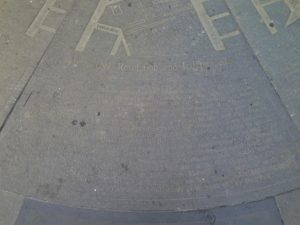
An unfortunately badly faded maker of the approximate location of where George Washington read the Declaration of Independence on July 9th 1776, in City Hall Park.
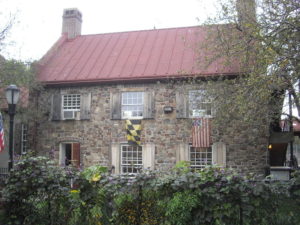 The Old Stone House in Park Slope, Brooklyn. The current building is a 1933 construction of a 1699 farmhouse and was fought ever during the Battle of Long Island.
The Old Stone House in Park Slope, Brooklyn. The current building is a 1933 construction of a 1699 farmhouse and was fought ever during the Battle of Long Island.
4. Old Stone House
The Old Stone House in Park Slope in Brooklyn is a 1933 reconstruction of the Vechte-Cortelyou House built in 1699, and the reconstruction used some of it’s original stones. The house was an important location in the Battle of Long Island in 1776, the largest engagement in the American Revolution. The house was fought over due to it’s strategic location and captured by Washington’s troops twice. However, ultimately, Washington would flee the area and abandon New York entirely to the British in order to preserve the Continental Army. The House today contains a museum of the battle including a 3D map with miniatures.
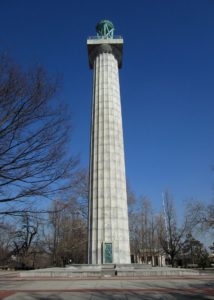 The Prison Ship Martyr’s Monument in Fort Greene Park in Brooklyn.
The Prison Ship Martyr’s Monument in Fort Greene Park in Brooklyn.
5. Prison Ship Martyr’s Monument in Fort Greene
This is without a doubt the most solemn monument in the city to the Revolutionary War. During the war, the British kept thousands of prisoners inside prison ships anchored in New York Harbor. around 11,500 prisoners died. The remains that were recovered were interred in what is now Fort Greene Park in Brooklyn at the Prison Ship Martyr’s Monument. The crypt is beneath the ground and it is marked by an obelisk dedicated in 1908 by President Howard Taft and designed by Stanford White.
6. Morris-Jumel Mansion
The 1765 Greek-Revival home of Robert Morris in Washington Heights in Manhattan was used as a headquarters by George Washington in late 1776 after he abandoned Brooklyn in the Battle of Long Island. Washington would later flee New York entirely. The house was also used by British General Henry Clinton. Later, during his presidency, Washington used the house to host formal dinners. The mansion is open as a museum and is filled with period furniture and has frequent events that commemorate its Revolutionary War history.
 The Morris Jumel Mansion in Washington Heights, Manhattan, built in 1765 and used as a headquarters by both sides during the American Revolution. In the 183s it was briefly a home of Aaron Burr who had a year long marriage with the then-matron Eliza Jumel.
The Morris Jumel Mansion in Washington Heights, Manhattan, built in 1765 and used as a headquarters by both sides during the American Revolution. In the 183s it was briefly a home of Aaron Burr who had a year long marriage with the then-matron Eliza Jumel.  The 1748 Van Cortlandt House. Washington stayed here three times during the Revolutionary War.
The 1748 Van Cortlandt House. Washington stayed here three times during the Revolutionary War.
7. Van Cortlandt House
This preserved colonial house in the northern edge of the Bronx, thankfully near the last stop on the 1 train, was used three times by George Washington, including once when he lit bonfires here to confuse British forces. Also, the owner, Augustus Van Cortlandt, the city clerk, hid New York City records here from the British while the city was occupied. From here, in 1783, George Washington departed south to New York City (then the city was 15 miles south) to officially liberate Gotham from the British.
 St Paul’s Church, built in 1764 located in today’s Mount Vernon, NY.. It was called the Church of Eastchester until 1795.
St Paul’s Church, built in 1764 located in today’s Mount Vernon, NY.. It was called the Church of Eastchester until 1795.
8. St Paul’s Church National Historic Site
This very pleasant spot is technically in Mount Vernon in Westchester County bu it is a short walk from the Eastchester/Dyre Ave station on the 5 Train in the Bronx. St Paul’s Church was built in 1764 (the congregation was founded in 1665 and it was called the Church of Eastchester originally). In 1776 the Battle of Pell Point was fought nearby and the British used it as a hospital. The bell inside the church was caste in 1748 at the same foundry in London as the Liberty Bell. The church is now a National Historic Site and has regular education events and a visitor-center telling of the sites importance during the revolutionary war and the region.
by John Semlak | Jun 25, 2016 | #SportsHistory, Uncategorized
The European Football Championship (not to be confused with the European Cup) is in the second round of 16 teams. Soccer ans of all the 16 nations still in the tournament are made for their teams. New York is full of European immigrants, expatriates, and local fans who follow their favorite team.
Below is a map of bars and restaurants friendly to the teams listed–click and enlarge the map to see them listed alphabetically by country on the left sidebar.
by John Semlak | Jun 22, 2016 | #NYCHistory

Stain glass window at Sage Chapel at Cornell University, Schwerner’s Alma Mater
On 21 June 1964, Mickey Schwerner, Andrew Goodman, and James Chaney traveled to the Mount Zion Methodist Church near Philadelphia in Neshoba Country, Mississippi. Schwerner and Chaney had been there a month previously the encourage the congregation to set up a Freedom School and encourage local African-Americans to vote. While they were at an activist training camp for the 1964 Freedom Summer campaign in at the Western College for Women in Oxford, Ohio (now Miami University), they learned the church was burned down by the Ku Klux Klan. They drove down to investigate.
After witnessing the destruction and speaking to its congregation, the three activists began a drive to Meridian, a nearby town where the organization, CORE (Congress of Racial Equality) had a base. Neshoba County was considered dangerous for Civil Rights workers (even by Mississippi standards). They had a flat and were then pulled over by Neshoba County Deputy Sheriff Cecil Price. The three were arrested for speeding and held for several hours but then released. They began a drive back to Meridian. Before they got out of the county they were pulled over by Cecil Price again. This time he was with a lynch mob of over a dozen KKK members. The three CORE activists were killed. They were murdered for helping African Americans register to vote.
Schwerner and Goodman both came from a New York Jewish tradition of social activism (which also produced 2016 presidential candidate Bernie Sanders) and were among many who traveled to the South to work for greater social justice. Andrew Goodman grew up on 86th Street on the Upper West Side and was a classmate with Paul Simon at Queens College. Schwerner grew up in Pelham, New York in Westchester County. He started his social activism at the ‘Downtown CORE in the Lower East Side in Manhattan.
Another activist from New York was Robert Parris Moses (not that Robert Moses). Moses was from Harlem and graduated from Stuyvesant High School and Hamilton College and became a field secretary at the Student Non-violent Coordinating Committee and was later co-director of COFO (Council of Federated Organizations), an umbrella organization for civil rights groups and based in Mississippi. He was one of the primary organizers of the Freedom Summer project. When the workers Chaney, Schwerner and Goodman went missing, he gathered the rest of the workers in his office told them that this was the risk they were taking they could leave. All the workers chose to stay.
Outrage over the murder of the three workers nationwide helped galvanize opinion nationwide and helped lead to Civil Rights Act of 1964 and the Voting Rights Act of 1965.
 Historic marker of the murder location, at a small rural road called Rock Cut Road
Historic marker of the murder location, at a small rural road called Rock Cut Road
by John Semlak | Jun 18, 2016 | #NYCHistory
 16th-century tapestry illustrating an Iranian arms workshop
16th-century tapestry illustrating an Iranian arms workshop  Pole arms and armor from the Arms and Armor exhibit
Pole arms and armor from the Arms and Armor exhibit
For young visitors, as well as a certain kind of geek, one of the most popular exhibits at the Metropolitan Museum of Art is the Arms and Armor exhibit, which features historic weaponry from as early as the 14th century. While mostly from late Medieval and Renaissance Europe, the exhibit als contains arms from Asia and the Americas, including early firearms. In the future the exhibit will be the subject of a more extensive post on this blog. However, currently adjacent to the main Arms exhibit is a temporary exhibit on weapons from the Muslim world, on view until 2 Jan 2017.
 18th century Persisn weapons
18th century Persisn weapons  From 19th-century Sudan
From 19th-century Sudan
The special exhibit is in conjunction with a book on the subject just published by the Met. Though most objects are from the 16th – 19th centuries, one Iranian sword dates from the 9th century. Several weapons look more ceremonial than combat-worthy, featuring encrusted jewels and beautiful scabbards. For medievalists and weapons enthusiasts it’s an essential stop at the Met. It’s room #380 and it’s just East of the Arms and Armor exhibit on the 1st floor.
 Ottoman saber and helmet from the 16th century.The weapons bear Arabic inscriptions.
Ottoman saber and helmet from the 16th century.The weapons bear Arabic inscriptions.
Remember that all exhibits at the Met are viewable with the museum’s general admission, which is pay-as-you-wish. See the museum website for visiting information.
 19th century Iranian mace and dagger
19th century Iranian mace and dagger  19th century Algerian flintlock pistols
19th century Algerian flintlock pistols
by John Semlak | Jun 13, 2016 | #NYCParks
 North Woods in Autumn
North Woods in Autumn
Central Park is justifiably New York City’s most popular tourist attraction, visited by 42 million people annually. Most tourists spend the majority of their time in the southern portion of the park, around iconic sites like the Bethesda Fountain, the Bow Bridge, and Strawberry Fields. A few venture a little further north to Belvedere Castle or the Conservatory Pond (and the Alice and Wonderland Statue. But many visitors–tourists and New Yorkers alike, do not visit the far northern portions of the park. And that is a great shame. Full of natural wonders and historic landmarks, the area roughly called the North Woods is perhaps the most enjoyable part of the park.
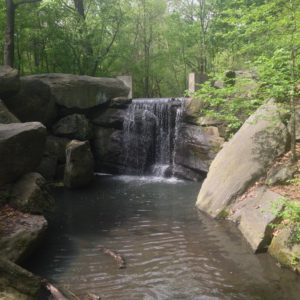
A waterfall near the Huddlestone Arch.
 The Loch in the North Woods. The North Woods was intended from the beginning to have a rugged appearance.
The Loch in the North Woods. The North Woods was intended from the beginning to have a rugged appearance.
The North Woods lies roughly north of 101st street in the western and central parts of the park, West of the Harlem Meer. Much of that portion of the park was acquired after the rest of the park was initially developed, and was intended to be more rugged. Along with Hallett’s Wildlife Sanctuary and the Ramble, it is one of three natural woodlands in the park and teeming with wildlife. Far less crowded with people than other parts of the park, the North Woods has the greatest variety of wild animals in Central Park.
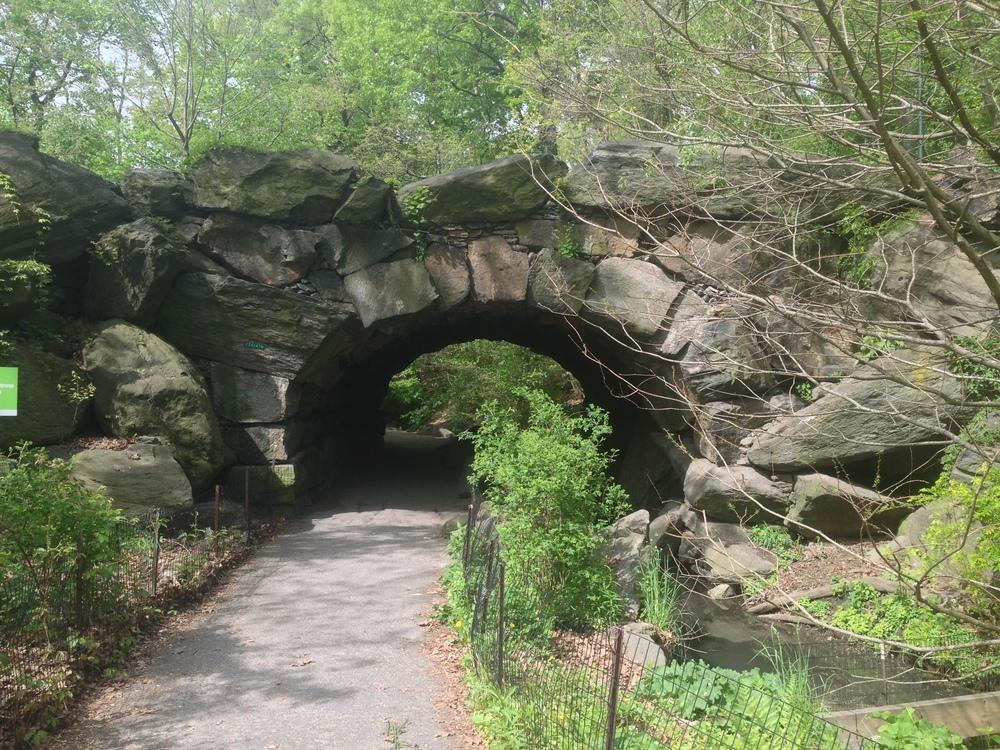 The Huddlestone Arch
The Huddlestone Arch
Within the North Woods is the Ravine, an artificial river called the Loch with several picturesque waterfalls. The Ravine contains three remarkable and distinct bridges. One the west end is the Glen Span Arch, a stone bridge built in 1865. In the middle is the small wooden footbridge called the Ravine Rustic Bridge. At the Northeastern end of the Ravine is the Huddlestone Arch, and 1866 bridge designed by Calvert Vaux made from 100 tons of boulders held together by gravity.
 The Rustic Ravine Bridge over the Loch
The Rustic Ravine Bridge over the Loch  the Harlem Meer and part of today’s version of McGowan’s Pass
the Harlem Meer and part of today’s version of McGowan’s Pass
Around the the edges of the North Woods are the remains of several fortifications that date back to before Central Park was created in the mid-1800s. The most well preserved is the Blockhouse, a fort built on a hill for the War of 1812. It is the oldest building in Central Park. To the East is Fort Clinton, The fort built in 1814 no longer remains, but the spot is marked by two 18th century cannons recovered from a British warship the Hussar. Nearby are Nutter’s Battery and Fort Fish, both sites for former early 19th-century fortifications. These forts guarded the entrance into Manhattan by McGowan’s Pass, a path that wound through the then rugged terrain into lower Manhattan. .
 The Blockhouse. Built in 1814, it is the oldest building in Central Park
The Blockhouse. Built in 1814, it is the oldest building in Central Park
Finally, a visit to the North Woods can be finished with a stunning contrast–the Conservatory Gardens, a highly manicured formal garden on the East side of Central Park’s northern portion. A far cry from the rugged natural beauty of the North Woods, the Conservatory Garden features beautiful flowerbeds, lovely statues, and wonderful fountains. It is popular with couples on a walk and a spot for weddings. Another great finish of a North Woods tour is the Harlem Meer Concession Stand just north of the Conservatory Garden, now occupied by a Moaz falafel stand.
 The Conservatory Garden
The Conservatory Garden
by John Semlak | Jun 9, 2016 | #AlexanderHamilton
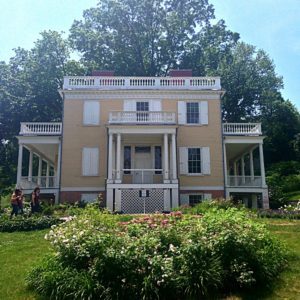
Hamilton Grange, Hamilton’s home from 1802-1804
New York is experiencing Hamilton-mania as fans in New York and from around the world are desperate for tickets for the hottest Broadway show perhaps ever. The musical about the life of Alexander Hamilton is setting records and is the talk of the town. Whether you’re fortunate enough to have have the sought-after tickets or you’ve just listened to the soundtrack, you can immerse yourself in Hamilton’s life at several places in New York.
Alexander Hamilton arrived in the US from the Caribbean island of Nevis in 1772, first studying at a boarding school in Elizabeth, New Jersey, before entering Kings College (today’s Columbia University) in 1773. Throughout his life he was a leading citizen of New York (the only New Yorker to sign the Constitution and one of the primary Founding Fathers of the United States) and his legacy exists all over the city and the surrounding area.
This is a list of 6 essential places to visit for Hamilton fans (besides the Richard Rogers Theatre of course). While there are many more which I’ll include in a map linked below–these are places that are more than a mere plaque or statue (New York City has 6 statues of Hamilton). They are sites where you have a tangible experience with the Founding Father either through artifacts or an actual building or site he spent time at.

A portrait of Hamilton at the Grange by John Trumbull
1. Hamilton Grange National Memorial
The only home Hamilton ever owned still stands in Harlem and is now a National Memorial run by the National Parks Service at 414 West 141st Street. It is open to the public and free of charge. It contains several Hamilton artifacts, including a piano his daughter actually played on, and exhibits of his life as well has a history of the Grange itself.
2. Trinity Church
Manhattan’s Trinity Church, at the beginning of Wall Street, is where Hamilton is buried. Next to him is his wife Elizabeth Schuyler. Church is also the site of the first location of Columbia University, founded as King’s College in 1755. The first classes were held at the church schoolhouse on the grounds (no longer standing) and Hamilton probably attended the church from time to time (that building now longer stands–the current church was built in 1846 at the same site). In Hamilton’s time the college was at College Hall, a building that stood Church and Murray Streets until 1847 (a cornerstone of the building is at Low Library of today’s campus).
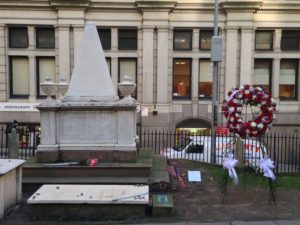
Hamilton’s tomb
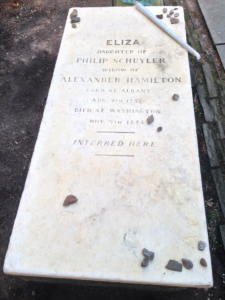
Grave of his wife Elizabeth Schuyler
3. Weehawken Dueling Grounds
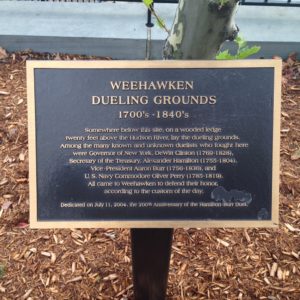
In July 11 1804 duel between Aaron Burr and Alexander Hamilton resulted in his death. Burr had been a political rival for years and the duel was meant to settle scores between the two, though not necessarily fatally. The dueling grounds had been a popular spot of duels which were outlawed in New York. The actual ledge where the duel took place is gone but a nearby spot is now a historic site. A bust of Hamilton is there and several historical markers detail the event. The Dueling Grounds also offer a panoramic view of New York City. Though best visited by car, pubic transport options are available from Manhattan, including the Hudson River Ferry.
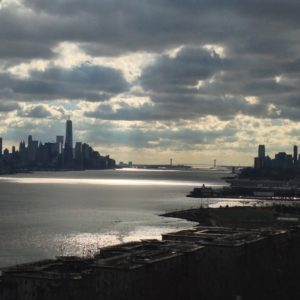
View from the Weehawken Dueling Grounds
4. Museum of American Finance
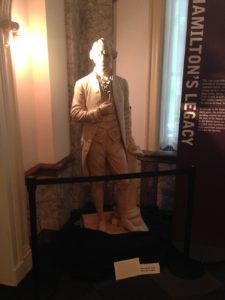
Statue at the entrance to the Hamilton Room at the Museum of American Finance
The Museum is inside the 1928 Bank of New York Building at 48 Wall Street, a bank that was founded by Hamilton in 1784. On the outside wall is a cornerstone of bank in 1797. In addition to several exhibits related to finance and the history of money, the museum features the Hamilton Room, containing several artifacts related to the Founding Father, including several documents he signed.
5. Fraunces Tavern
Founded in 1762 by Samuel Frances, this historic site is located at 54 Pearl Street. It was a popular tavern during the late Colonial, Revolutionary, and early Federal period of New York. It was frequently visited by George Washington and other prominent figures of the time. In 1804 Hamilton and Burr met there the week before their duel for a peaceful meal. The tavern still operates, and the upper floors are a museum. The present-day building is mostly a restoration done in 1907–though a few parts of the foundation and the walls may be original. Unfortunately there isn’t that much about Hamilton in the Museum–but Washington and Lafayette are heavily featured.

Frances Tavern, where Hamilton had his final meal.
6. Great Falls, Paterson New Jersey

The Great Falls in Paterson New Jersey
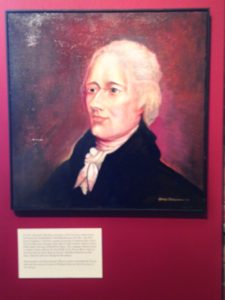
Portrait of Hamilton at the Paterson Museum
This is the only one of the 6 sites that requires a day trip. Paterson, New Jersey is located 20 miles from New York and can be reached by car or by train from Penn Station. The magnificent waterfall, itself worth a trip and is now a National Park. It was chosen by Alexander Hamilton as a place to power industry. In 1791 he founded the Society for Establishing Useful Manufactures at the Falls. Paterson became a planned industrial town and would become the site of manufacture of firearms (Colt Manufacturing was founded in Paterson in 1836), textiles, locomotives, and more. A 1922 statue of Hamilton overlooks the Falls. The nearby Paterson Museum is packed with exhibits of Paterson’s industrial history, including a small Hamilton section.
Other places:
New York City and the surrounding area features many more sites connected to Hamilton, some marked by plaques or statues. There are also sites connected to his political rival Aaron Burr, and a number of locations related to George Washington’s Continental Army (Hamilton served as his Chief-of-Staff.), particularly the Morris-Jumel Mansion which he used as a headquarters. See the map below for a comprehensive list of Hamilton-related sites in NY and the surrounding area.
by John Semlak | Jun 9, 2016 | #NYCHistory
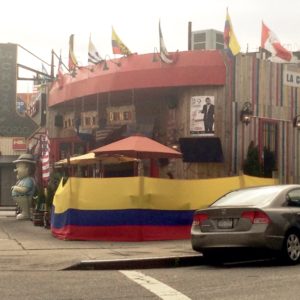
La Choza del Gordo in Long Island City in Queens
The Copa America is already underway. As I write this post we’re almost midway through the group stage involving all 16 teams. Then we move to the quarterfinals and beyond. The first match in the NY metro area will be on June 12th.
But you can experience the madness right here in New York City. Supporters of Team USA and the 15 other North and South American nations abound in NY and are packing various bars and restaurants to watch the matches.
In general it is best to simply go to a neighborhood where many of the first or second-generation immigrants from the nations playing live. The best area is Jackson Heights in Queens, an area with many South American immigrants and very vibrant during soccer tournaments involving them.
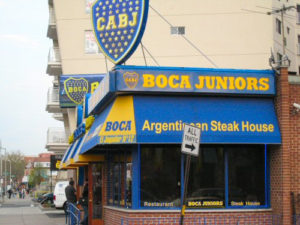
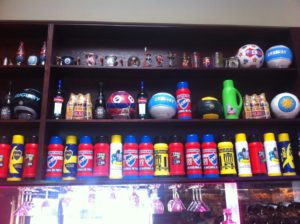
Football memorabilia inside La Gran Uruguaya
Two particular places I recommend are La Gran Uruguaya and Boca Juniors–both in Queens. La Gran Uruguaya, in Jackson Heights, is devoted to Uruguayan football. It is a bakery and a bar. Inside is Uruguayan soccer memorabilia. It is a fine place to watch any soccer match and attracts fans of many teams.
Boca Juniors, a steakhouse in Elmhurst on Queens Boulevard named after Argentina’s most famous soccer club. It’s absolutely packed during Argentina games and often features a band during big matches.
Here are some of the better places to watch the matches, sorted by country:
General soccer-friendly bars, and good for USA matches:
Legends: 33rd and 5th.Manhattan
Smithfield Hall NYC 138 W 25th St Manhattan
The Weir, 3rd Ave and 93rd St, Manhattan
Banter, 132 Havemeyer St, Williamsburg, Brooklyn
Woodwork, 583 Vanderbilt Ave, Prospect Heights Brooklyn
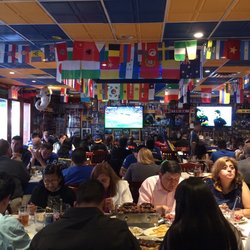
Boca Juniors during the 2014 World Cup
Argentina:
Boca Juniors, 81-08 Queens Blvd, Queens
Bolivia
Renacer, 67-03 Woodside Ave, Woodside, Queens
Brazil
Miss Favela, 57 S 5th St, Williamsburg, Brooklyn
Chile
San Antonio Bakery 3620 Astoria Blvd, Astoria, Queens
Colombia
El Basurero, 32-17 Steinway St, Astoria, Queens
El Abuelo Gozon, 79-03 Roosevelt Ave, Jackson Heights
Costa Rica
Olga’s Place, 214 LT Glenn Zamorski Dr, Elizabeth, NJ
Ecuador
Pequeno Coffee Shop, 8610 Roosevelt Ave, Jackson Heights, Queens

El Paso decorated for the 2014 World Cup
Mexico
Campeon, 9 E 16th St (15th and 5th), Manhattan
El Paso Restaurant, Lexington and 104th, East Harlem, Manhattan
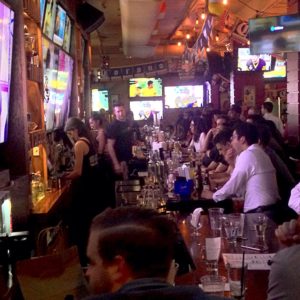
Mexican fans watching El Tri, the national team, at Campeon on 16th Street.
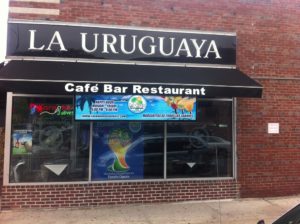
La Gran Uruguaya in Jackson Heights
Panama
Kelso, 648 Franklin Ave, Prospect Heights, Brooklyn
Paraguay
I Love Paraguay, 4316 Greenpoint Ave, Sunnyside, Queens
Peru
Amaru Bar, 84-13 Northern Blvd, Jackson Heights, Queens
Uruguay
La Gran Uruguaya, 85-06 37th Ave, Jackson Heights, Queens
Venezuela
Patacon Pisao, 85-22 Grand Ave, Elmhurst, Queens
by John Semlak | Jun 5, 2016 | #NYCSports
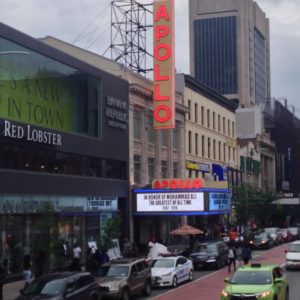
The Apollo Theater honors Muhammad Ali
Right now the world is morning the legendary boxer Muhammad Ali, a three time heavyweight boxing champion and global icon. Muhammad Ali was a citizen of the world, but perhaps New York City carries his legacy more than anywhere else. There are many places that he is associated with: the Apollo Theater is honoring his legacy. He trained at Gleason’s Gym in the Bronx (now in Brooklyn). But the place in NY he’s most associated is of course the place he fought four times, Madison Square Garden. One of those fights was called the Fight of the Century, his first fight with Joe Frazier.
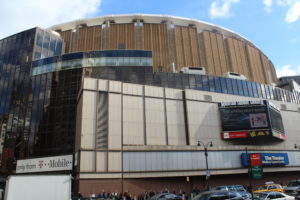
Madison Square Garden at Joe Louis Plaza at 8th and 33rd.

MSG at night
Muhammad Ali in fact fought in New York City 10 times. He fought at the 3rd Madison Square Garden four times as well, when it was located on 8th Avenue between 49th and 50th streets. He also fought at Yankee Stadium at at the now torn-down St Nicholas Arena.
Madison Square Garden has in fact had three locations in NYC in its history. The first two buildings were both on Madison Square (hence the name). Every one of the ‘Gardens’ has featured historic boxing matches–in 1882 James Sullivan won the heavyweight title in the Garden’s first site. Jack Dempsey defended his title against Bill Brennen in 1920. Joe Louis fought at the 3rd MSG 12 times (though his iconic fight with Max Schmeling was held at Yankee Stadium). In 1942 Sugar Ray Robinson and Jake LaMotta fought at the Garden.
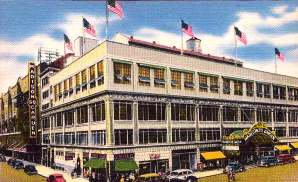
Postcard of the 3rd Madison Square Garden
Ali, then Cassius Clay, first fought at the 3rd Garden in 1962 against Sonny Banks. The entire fight is on Youtube. Banks floored Clay for the first time in his career but still lost in a 4th round TKO. Ali’s first fight at the present MSG was in 1970 vs Oscar Bonavena, after he returned to the ring following his exile from the sport due to his refusal to serve in Vietnam. But his biggest fight at the Garden was his first ever defeat, a fight that may have been the biggest ever. Due to his having been stripped of the title, in 1971 two previously undefeated heavyweight champions, Ali and Joe Frazier, met at Madison Square Garden. The fight received tremendous publicity and lived up to it. Ali dominated early but Frazier got into the match. He knocked Ali down twice. After the full 15 rounds, Frazier won by unanimous decision.
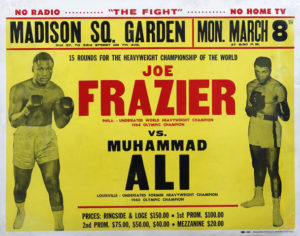
Ali and Frazier would fight again at the Garden in 1974, this time in a non-title fight after Frazier lost to George Foreman. Ali’s 12-round victory was the fight that preceded his victory over Foreman in Zaire.
Madison Square Garden still features boxing matches. In 2015 Vladimir Klitschko defeated Bryant Jennings in a heavyweight title match. MSG is the home stadium of the following area teams: the Knicks (NBA), the Rangers (NHL), St John’s University (college basketball), and the New York Liberty (a WNBA women’s professional team). The Arena also hosts many concerts. Billy Joel has played there more than any other music performer. You can also take a tour which highlights the sporting history of the arena.

Pele and Ali hug at Pele’s farewell match at Giants Stadium in 1977.
Until 1990, the Garden was the site of the International Boxing Hall of Fame. It was then moved to the town of Canastota in upstate NY. In addition to boxing artifacts such as trunks, belts, and gloves of famous boxers, the Hall of Fame features the actual ring used for the 1971 Fight of the Century.
Ali was a fan of other sports, and was a frequent attender of matches of the New York Cosmos and a friend of the legend Pele. Ali called Pele the ‘other Greatest.”
by John Semlak | Jun 3, 2016 | #NYCSports
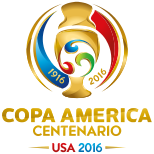
Logo of the tournament
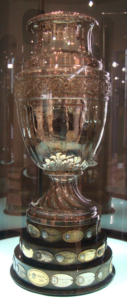
The trophy
On Friday June 3rd at 9 PM EST in Santa Clara CA, the USA and Columbia men’s football teams will kick off the 2016 Copa America, called the Centenario because it is celebrating the 100th year of the tournament. The tournament, which is formally the championship of South American national teams, features all 10 South American teams and 6 North American teams. The tournament will be played in 10 cities across the US from June 3-26th and the final will be played at Metlife Stadium in East Rutherford, New Jersey.
The Copa America is a historic tournament and is taken very seriously by Latin American nations and is followed around the world. Given South America’s preeminence in world football, the tournament usually involves many of the world’s best players. First played in 1916 in Argentina, the tournament pre-dates the World Cup by 14 years.
While it is the first time the tournament is being held outside South America, it has involved teams from outside the continent in the past. This is in part because there are 10 South American teams, and that’s an odd number for a tournament. In recent years the tournament has consisted of 12 teams with two invitees, usually Mexico and another country–often one that is a major media market like the USA or Japan. (In the world of international football, Mexico is a very rich media market btw). The US has gone three times in the past and in 1995 took 4th place.
Three matches will be played at Metlife Stadium. First on June 12th there is a group match between Ecuador and Haiti. Tickets are available on Ticketmaster and the cheapest seats are going for $223(!). The next match at Metlife will be a quarterfinal on June 17th, which will possibly involve the US if they finish second in their group. (Their most likely opponent would be Brazil). Then on 26th of June the final will take place at Metlife. Metlife stadium, which of course is home to the New York Giants and New York Jets in that other kind of football, is easily accessible by train from Penn Station in Manhattan as well as by car.
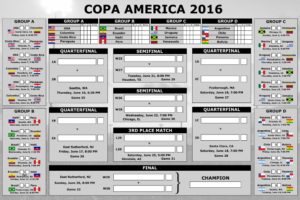
Copa America match chart and schedule
Besides physically attending the matches, it will be possible to take part in the Copa atmosphere in many places around the city. New York City has significant populations of each nation that is taking part in the tournament, and fans will be packing bars and restaurants around the city that show the games or gathering together at people’s homes. The matches will all be shown live on US tv–a few will be on Fox’s main broadcast network and the remaining will be on their affiliated cable channels. Also, all the matches will be broadcast in Spanish on Univision which is available free-to-air in much of the city via antenna. (Full details on tv and streaming options here). And with the European football championship starting a week later (I’ll be blogging on that next week), New York will be experiencing soccer-mania for most of June.
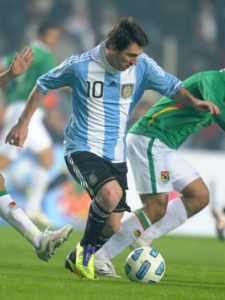
Argentina star Lionel Messi at the 2011 Copa America

USA star Michael Bradley
The favorite to win the tournament is Argentina, given roughly 2-1 odds in the betting markets. Their attack will be led by Barcelona star Lionel Messi and will feature players from top clubs in Europe. The 2nd favorite is Brazil at 5-1. Brazil’s superstar Neymar is unfortunately not taking part–Brazil’s team appears to be focusing on the Olympic soccer tournament later in the summer. But Brazil’s team will still feature many top players. Columbia, the USA (with home field advantage) and Uruguay (which features former Liverpool and current Barcelona star Luis Suarez) all have an outside chance.. Chile is the defending champion and previous host, and Mexico will also be a strong contender and some pundits are predicting that El Tri, which in the US is practically a home team with the large Mexican-American population, will win the trophy.
The USA will be led by veterans Clint Dempsey and Michael Bradley. Dempsey, now 33, is perhaps making his final hurrah with US team, while Bradley is looking to establish himself and the team’s leader and star player. A preview of the USA-Columbia match is here. Sports Illustrated’s Planet Futbol site has a thorough preview of the whole tournament. A good English journalist to follow who is an established expert on South American football is Tim Vickery.
This weekend I’ll put up post on places in the city to watch the matches.
by John Semlak | May 28, 2016 | #NYCSports

Tomorrow, Saturday May 28th at 2:45 pm is the Champions League final, European Soccer’s biggest prize. This year’s final is an all-Madrid derby between Atletico Madrid and 10-time champion Real Madrid, a rematch of the 2014 final won by Real. Around this time, New York’s football (the real kind) fans and visiting tourists wonder, ‘Where can I watch the match?” The answer, thankfully, is pretty much everywhere. You won’t have difficulty finding a bar with game on. The match will be on live on free-to-air tv on Fox (channel 5.1 over an antenna) or on ESPN Deportes in Spanish. It can also be streamed on a phone over foxsoccer2go.com
A few weeks ago I published a post recommending where to watch England’s Leicester City clinch the Premier League. Most of the bars listed there will be very good, if crowded, places to watch the match. But given the particularly Castilian flavor of this final, I think it’s worth recommending a few specific places in New York to get an experience unique to this match.
 Real Madrid superstar Cristiano Ronaldo
Real Madrid superstar Cristiano Ronaldo
1. Barleycorn: Craft Beer and Grill
Tne Real Madrid NYC Supporters Club will be meeting a Barleycorn at 23 Park Pl in Tribeca. It’s a solid soccer venue downtown otherwise. It’s not their regular spot–they move around. In the past they had met regularly at Quinns Bar and Grill in Hell’s Kitchen but it closed last February.
 Crest of Atletico Madrid, Real’s local rival.
Crest of Atletico Madrid, Real’s local rival.
2, Suite 36, 14 W 36th Street, Midtown
Suite 36 is the regular gathering spot of NYC supporters of Atletico Madrid. Expect a mostly Spanish-speaking crowd.
3. Donostia, 155 Avenue B, East Village
This Basque-themed Spanish venue in the East Village will offer an Iberian flavor with a neutral (?) atmosphere. Unfortunatlery, the previous go-to Spanish spot for Spanish football, La Nacional, has closed (temporarily we are told).
4. Fornos of Spain Restaurant, 47 Ferry St, Newark
OK, it’s not New York City, but definitely within the NY Metro area and accessible from Manhattan by the PATH rail system. Newark’s Ironbound neighborhood has historically been home to Spanish and Portuguese communities and has several restaurants to boast (given that many of the players on both teams are Portuguese, those restaurants may also be worth a try).
My prediction: the winner will be football.




 The Old Stone House in Park Slope, Brooklyn. The current building is a 1933 construction of a 1699 farmhouse and was fought ever during the Battle of Long Island.
The Old Stone House in Park Slope, Brooklyn. The current building is a 1933 construction of a 1699 farmhouse and was fought ever during the Battle of Long Island. The Prison Ship Martyr’s Monument in Fort Greene Park in Brooklyn.
The Prison Ship Martyr’s Monument in Fort Greene Park in Brooklyn. The Morris Jumel Mansion in Washington Heights, Manhattan, built in 1765 and used as a headquarters by both sides during the American Revolution. In the 183s it was briefly a home of Aaron Burr who had a year long marriage with the then-matron Eliza Jumel.
The Morris Jumel Mansion in Washington Heights, Manhattan, built in 1765 and used as a headquarters by both sides during the American Revolution. In the 183s it was briefly a home of Aaron Burr who had a year long marriage with the then-matron Eliza Jumel.  The 1748 Van Cortlandt House. Washington stayed here three times during the Revolutionary War.
The 1748 Van Cortlandt House. Washington stayed here three times during the Revolutionary War. St Paul’s Church, built in 1764 located in today’s Mount Vernon, NY.. It was called the Church of Eastchester until 1795.
St Paul’s Church, built in 1764 located in today’s Mount Vernon, NY.. It was called the Church of Eastchester until 1795.
 Historic marker of the murder location, at a small rural road called Rock Cut Road
Historic marker of the murder location, at a small rural road called Rock Cut Road 16th-century tapestry illustrating an Iranian arms workshop
16th-century tapestry illustrating an Iranian arms workshop  Pole arms and armor from the Arms and Armor exhibit
Pole arms and armor from the Arms and Armor exhibit 18th century Persisn weapons
18th century Persisn weapons  From 19th-century Sudan
From 19th-century Sudan Ottoman saber and helmet from the 16th century.The weapons bear Arabic inscriptions.
Ottoman saber and helmet from the 16th century.The weapons bear Arabic inscriptions. 19th century Iranian mace and dagger
19th century Iranian mace and dagger  19th century Algerian flintlock pistols
19th century Algerian flintlock pistols North Woods in Autumn
North Woods in Autumn
 The Loch in the North Woods. The North Woods was intended from the beginning to have a rugged appearance.
The Loch in the North Woods. The North Woods was intended from the beginning to have a rugged appearance. The Huddlestone Arch
The Huddlestone Arch The Rustic Ravine Bridge over the Loch
The Rustic Ravine Bridge over the Loch  the Harlem Meer and part of today’s version of McGowan’s Pass
the Harlem Meer and part of today’s version of McGowan’s Pass The Blockhouse. Built in 1814, it is the oldest building in Central Park
The Blockhouse. Built in 1814, it is the oldest building in Central Park The Conservatory Garden
The Conservatory Garden



























 Real Madrid superstar Cristiano Ronaldo
Real Madrid superstar Cristiano Ronaldo Crest of Atletico Madrid, Real’s local rival.
Crest of Atletico Madrid, Real’s local rival.